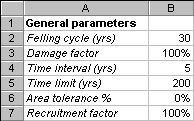 The {Models} sheet sets both general model parameters, and the species group models. The general parameters which may be set are shown at the right as they occur in the worksheet from cells B2:B7:
The {Models} sheet sets both general model parameters, and the species group models. The general parameters which may be set are shown at the right as they occur in the worksheet from cells B2:B7:
for the MERLYN harvesting model
 The {Models} sheet sets both general model parameters, and the species group models. The general parameters which may be set are shown at the right as they occur in the worksheet from cells B2:B7:
The {Models} sheet sets both general model parameters, and the species group models. The general parameters which may be set are shown at the right as they occur in the worksheet from cells B2:B7:
Felling cycle: This determines the area of the forest harvested in each year. The total area is calculated as the sum of the block areas. This area divided by the felling cycle gives an annual coupe. The model actually works with periodic coupes, and multiplies the annual area by the time interval given in B4.
Damage factor: The logging damage factor is a multiplier applied to the ratio of harvested volume over standing volume to calculate damage in each size class as a percentage of the number of stems. For example, if 20% of the stand volume is harvested, and the damage factor is 1 (or 100%), then 20% of each size class (after felling removals) will be assumed to die or be severely damaged during felling. The formula used in the model is:
f = F.Vh / Vst
where f is the damage % applied to each size class, F is the damage factor entered as a model parameter,Vh is volume harvested, and Vst is volume before harvest. A damage factor of 1 (100%) is suggested as an appropriate rule-of-thumb if no better information is available from local damage studies. Note that the damaged trees include non-commercial stems and smaller sizes classes, so the actual impact on advance growth of commercial species may be minimal.
Time interval: The model works by projecting growth cumulatively over short intervals of time from one year upwards. It is recommended that a 5-year interval is normally used, unless there are strong reasons to the contrary. The number of lines of output will increase as time interval is shortened. An interval longer than 5 years may result in some degradation of performance.
Time limit: This defines the total period over which simulations should run. Up to about 100 years, the model will be projecting the growth of existing small trees as they reach commercial sizes, and can be regarded as likely to give reasonable results. Longer projections depend totally on the recruitment assumptions, and must be regarded as increasingly uncertain. It is not recommended that projections beyond 200 years are made except for testing purposes.
Area tolerance: The model will determine a coupe area based on the felling cycle. The area tolerance is the percentage deviation in coupe area that may be allowed in order to make coupes correspond as much as possible with forest blocks. By setting it to a value of around 5%, the model avoids dividing blocks into sub-blocks that are small slivers of forest of a few ha.
Recruitment factor: The model assumes that each tree that dies or is felled will be a replaced by a number of recruits at the smallest measured size. A recruitment factor of 100% means 1:1 replacement, and gives a stable tree population over the long term.
Below the general parameters come settings for each species group. These are illustrated below:

The D95, Dinc and AMR figures are copied from the MYRLIN#2 {table} sheet, or can be entered directly from other sources. They give, respectively, the 95% cumulative diameter for the species, as a measure of mature size; the mean diameter increment, in cm/yr, and the annual mortality rate, in %/year. Dlim and Harv% are forest management factors for the species group, and are discussed elsewhere. The Vol/BA ratio is the form height for the species (or ratio of volume to basal area), and is used in the model to calculate volume. If this is not known, a rule of thumb applicable to moist tropical forest is that it is likely to be about 10 for many species.